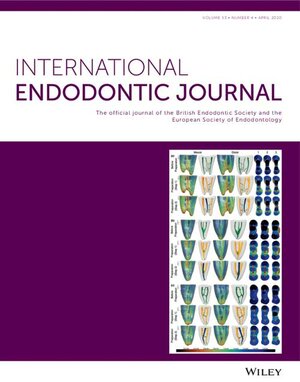2D versus 3D radiographic assessment of asymptomatic persistent endodontic lesions
Abstract
Aim
This prospective cohort study aimed to study lesion size, proximity to anatomical structures and detection of missed canals using 2D digital periapical (PA) radiographs and 3D cone beam computed tomography (CBCT) radiographic imaging, amongst a cohort of asymptomatic persistent endodontic lesions (APEL), and to develop a radiographic protocol for these asymptomatic lesions.
Methodology
APEL persisting ≥4 years after endodontic treatment were recruited with informed consent. PA radiographs taken at different angles (KaVo Kerr, Brea, CA) and a limited field-of-view CBCT scan (KaVo Kerr, Brea, CA) of 0.125mm3 voxel size were evaluated. Two calibrated independent endodontic practitioners examined all radiographic images in a random and blinded sequence, under similar viewing conditions. Agreement above chance (kappa) was calculated for parameters of interest (Graphpad by Dotmatics, https://www.graphpad.com/).
Results
Eighty-two APEL (15 incisors, 25 premolars, 42 molars; 59.8% treated 4–10 years prior) in 77 patients (34 male, 43 female, median age 51–60) were examined. Root filling quality was acceptable with 14/82 (17.0%) lacking density and homogeneity. Weighted kappa on lesion size (0.5–1.9, 2–4.9 and 5–9.9 mm) between PA radiographs and CBCT was 0.466 – in 24 APEL, lesion size was >2 mm larger on CBCT whilst in 4 APEL, lesions were >2 mm smaller on CBCT. On proximity to maxillary sinus and neurovascular structures (‘yes’, ‘no’, ‘unable to tell’), kappa was 0.237, with 9 APEL scored ‘unable to tell’ on PA radiographs and 0 uncertainty on CBCT. Agreement between PA radiographs and CBCT on missed canals (‘not likely’, ‘somewhat likely’, ‘very likely’, ‘unable to tell’) was 0.349, with 13 teeth scored ‘somewhat likely’ and ‘very likely’ on CBCT and only 6 teeth similarly scored on PA.
Conclusion
Overall, CBCT provided a more comprehensive examination of teeth with APEL than PA radiographs. Larger lesion sizes were generally observed, especially in posterior teeth. Sinus involvement was more readily identified, and the assessment of the presence of missed canals could be performed with more certainty. Where lesion monitoring is chosen, CBCT imaging should be considered for a more thorough assessment of posterior teeth, and where there is uncertainty in PA radiograph interpretation of anterior teeth.


 求助内容:
求助内容: 应助结果提醒方式:
应助结果提醒方式:


